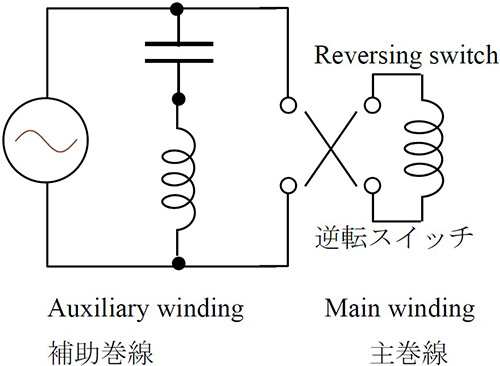Glossary of Motor Terms
Capacitor-run motor, Capacitor-start motor
The capacitor-run motor is a representative example of the rotating-field single-phase AC induction motor. Its main application lies in fans. It has a two-phase winding configuration consisting of the main and auxiliary windings. A capacitance of about 3μF is connected to the auxiliary winding, as shown in the figure. Its function is to advance the phase of the current of the auxiliary winding by about 90° relative to the current of the main winding to create a rotating field. Switching of the rotation direction, for applications that require it, is done by reversing the terminals of either winding. In the figure, the main winding is reversed.
Though the capacitor-run motor has a simple construction and can be operated easily, the capacitance rating must be varied depending on the supply frequency, i.e., 60Hz or 50Hz, to have the ratio 1:1.4. Furthermore, since a motor with the same specifications will have different rotational speeds, having the ratio 1.2:1, in areas supplied by 60Hz and 50Hz mains, different designs were required, particularly for tape-recorders. The brushless motor was developed to avoid this inconvenience, although it requires a complex drive method.
One method to start up the single-phase induction motor, which is relatively large among compact motors, is by using an auxiliary winding, which is disconnected as soon as the motor is running. This is the capacitor-start motor. The rotational direction is difficult to reverse with this configuration.

Term List (C)
- Capacitor-run motor, Capacitor-start motor
- Carbon brush, Graphite brush, Metallic graphite brush
- Circulating current
- Coercive force, coercive intensity
- Cogging torque
- Commutation
- Commutator, Commutator segment
- Concave and Convex
- Concentrated winding
- Concentric winding
- Concentricity, Eccentricity
- Conductor
- Consequent pole
- Constant-power characteristics
- Construction of a DC motor
- Continuity of magnetic fields
- Cooling methods
- Copper machine, iron machine
- Core, Iron core, Laminated core, Lamination
- Coreless motor
- Coulomb friction
- Coupling,Rigid coupling
- Cylindrical motor

